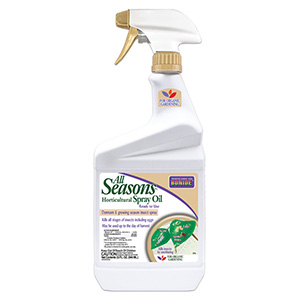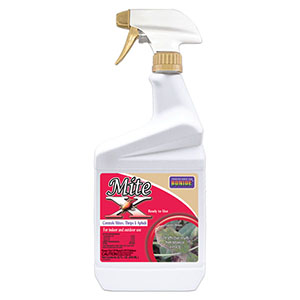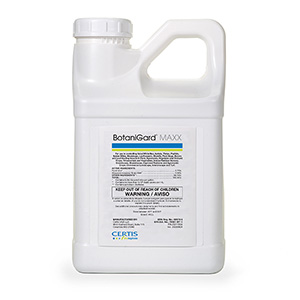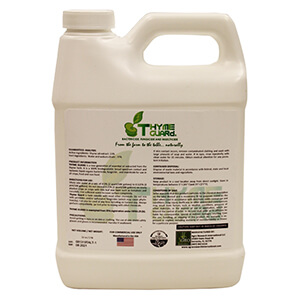Broad Mites & Cyclamen Mites
Broad and Cyclamen Mites are tiny arachnids (<0.2 mm in length) that are common pests of strawberries, African violet, ivy and more. Distributed worldwide, broad and cyclamen mites have become major pests to a range of commercial crops and have proven difficult to control. Much of the difficulty in controlling them stems from their minute size and how difficult they are to successfully identify. Use a minimum magnification of a 10x loupe or magnifying glass to get a better look!
Identification & Life Cycle:
- Eggs – Elliptical in shape, transluscent and colorless and laid in clusters with white tufts covering the tops.
- Larvae (1st Instar) – Generally slow moving with a whitish appearance, young cyclamen and broad mites have three pairs of legs and can be 0.1-0.2 mm long. This stage lasts one day.
- Nymph (2nd & 3rd Instar) – Clear and pointed at both ends, nymphs are generally found in depressions on fruit and females can be carried by males. Usually lasts one day.
- Adult – Males are oval shaped and short with long, thin legs. Females are also oval shaped, but more swollen than the adult males. Males live for 5-9 days while females live for 8-13 days. Females will lay approximately 5 eggs per day (30-75 eggs in a lifetime), which can be found on the undersides of leaves and on small fruit. Most dispersal occurs through males carrying female larvae to new leaves and plants, but there is evidence showing other insects like whiteflies carrying mites from plant to plant. In outdoor settings, adults will often be found on shaded areas of the plant making them harder to spot.
Damage Symptoms:
Broad and cyclamen mites have a wide host range and are most prevalent in tropical regions, but are found in greenhouses in more temperate regions. These mite species are widespread and a major pest of both commercial and ornamental crops. They prefer feeding on new growth causing it to twist and harden. Leaves will turn downward and discolor while blooms may abort in the presence of larger mite populations. Streaking on foliage may be evident with flowers becoming deformed and/or reduced in number. Developing fruit will discolor and premature fruit drop can also occur.
Control & Management:
Sanitation is imperative throughout cultivation and between growing seasons. This can be as simple as increasing air flow in the growing area, but can include things like sanitizing the Growing Medium and thorough cleaning of all surfaces.
For situations where a mite population has established itself and high mite levels are already present, knockdown sprays may be necessary before introducing beneficial insects. Contact Insecticide sprays, like Neem Oil, Debug Turbo, Azera Gardening and Pyganic Gardening, can be applied directly onto mite populations to suppress them to more manageable levels. Residual insecticides (Horticultural Oils) can also be applied for longer lasting control of all life stages both in and out of season. Always look into possible impacts on pollinators, beneficials and other animal life before using an insecticide.
If a mite population develops, consider introducing Mite Predators. There are many mite predators and they each work best in specific environments. When choosing a mite predator, look for an optimal temperature range and relative humidity compatible with your growing environment. Specialist Insects will target specific pest insects and generally have more restrictive optimal conditions than Generalist Insects. If you have questions about the proper beneficial insect for you, please call us at 1-800-827-2847.
- Mite Predator, Neosiulus fallacis - Thrives in moderate to cool conditions with higher humidity levels; highly recommended in greenhouse settings. 55-80°F, 50%+ RH
- Mite Predator, Amblyseius andersoni - Survives on Mites, Thrips, pollen, honeydew and fungi making them great for both preventative and active control measure. 42-100°F, higher RH for higher temperatures
- Mite Predator, Amblyseius swirskii - Rapid development and wide-ranging food sources are two of their main benefits. Commonly used for Mite, Thrips and Whitefly infestations. 60-85°F, 70% RH
- Mite Predator, Neoseiulus californicus - Versatile and tolerant of a wider range of temperatures and lower humidity than P. Persimilis. 50-105°F, 40-80% RH
- Thrips Predator, Amblyseius cucumeris - Great when used alongside Orius insidiosus and in greenhouse releases. 66-80°F, 65-72% RH
PLEASE NOTE: All Mite Predators require additional processing time due to rearing and collection times. Please make note of the information in red at the top of each mite predator page and in the Shipping Tab to identify the earliest shipment date. If you have questions about shipment dates, orders can be placed with our sales representatives at 1-800-827-2847.
-
$140.00–$720.00
-
$30.00–$200.00
-
$25.00–$600.00
-
$68.00–$500.00
-
$144.00
-
$38.50–$142.00
-
$43.00–$128.00
-
$80.00–$750.00
-
$38.00–$240.00
-
$23.00–$85.00
-
$80.00–$105.00
-
$21.99
-
$38.35–$150.08
-
$275.00–$2,495.00
-
-
$5.49–$9.99
-
$9.49–$17.00
-
$11.97–$34.99
-
$115.00–$1,314.00
-
$80.00–$1,026.00
-
-
-
-
$73.80–$3,005.00
-
$11.99–$299.99
-
$149.00–$1,149.00
-
$19.00–$3,845.00
-
$350.00–$975.00
-
-
$10.99–$32.49
$6.00–$32.49 -
$14.99–$144.49
-
$38.50–$4,350.00
-
$320.00–$3,168.00
-
$280.00
-
$35.00–$350.00
-
$35.00–$285.00
-
$175.00–$300.00
-
$90.00–$710.00
-
$22.99–$131.95
-
$32.97–$118.33
-
$58.00–$260.00












































